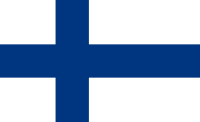Finland, the easternmost of the Scandinavian countries, is not only notable for its special language, which belongs to the Finno-Ugric rather than the Scandinavian language family, but also had to fight for its independence until the 20th century. The Finnish flag is a symbol of this. But when and how exactly was the flag of Finland created?
What makes up the flag of Finland?
The Finnish flag in blue and white has been the official national flag of Finland since 29 May 1918 and is considered a symbol of independence. The blue and white of the national flag stands for the lakes and snow that characterise Finland.
The appearance of the Finnish flag
The flag of Finland consists of a blue Scandinavian cross on a white background. Like the national flags of Norway, Sweden, Iceland and the Faroe Islands, it is based on the Dannebrog, the oldest flag in Scandinavia and one of the oldest flags in the world.

The history of the Finnish national flag
The history of the Finnish flag is comparatively young. This is because Finland only gained independence from Russia, of which it had been a Grand Duchy since 1809, in 1917. Prior to that, the country had been part of the Swedish Empire since the Middle Ages – due to its history, Finland never had its own flag.
Finland only received its own flag on 29 May 1918, which was intended as a symbol of its independence and was designed by Eero Snellman and Bruno Tuukkanen.
Affiliation with Sweden
1323: Finland joins Sweden
In 1323, a large part of present-day Finland fell to Sweden. Only Karelia in Eastern Finland was annexed to the Russian Empire.
1808/1809: detachment from Sweden
Following the Finnish War, which led to the Russian occupation of Finland, Sweden had to cede large parts of Finland to Russia.
Affiliation with the Russian Empire
1809: annexation to the Russian Empire
After the end of the Finnish War, most of present-day Finland was annexed to the Russian Empire.
1917: independence of Finland and introduction of the Finnish flag as the national flag
Finland gained its independence from the Russian Empire in 1917. The Finnish Declaration of Independence was adopted by Parliament on 6 December 1919. This made Finland a sovereign republic from 1919.
Emergence of the national flag
1918: introduction of the state flag as the national flag of Finland

On 29 May 1918, the flag of Finland was introduced as a legally valid national flag. It was designed by the artists Eero Snellman and Bruno Tuukkanen.
What does the Finnish flag mean?
The flag itself has a strong symbolic power for the Finns, as it was designed for their independence. In addition to the Scandinavian cross, which shows the connection to the other Scandinavian countries, the colours also have an individual meaning.
Blue and white: this is what the colours symbolise
The white background symbolises the snow of the deep Finnish winters, while the blue of the Scandinavian cross represents the Finnish lakes. Finland is therefore known as the “land of a thousand lakes”.
The quote that the flag contains the“blue of our lakes and the snow-white of our winters” is also repeatedly associated with the Finnish flag.
The colours of the Finnish flag are therefore particularly typical of the easternmost country in Scandinavia. They represent nature and the landscape, which traditionally play a major role for the Finns.

National coat of arms: the Finnish national flag
In addition to the national flag, the state flag is in use as well. It, however, may only be used by state institutions. It is very similar to the national flag, the only difference being the Finnish coat of arms in the centre of the Scandinavian cross.
The coat of arms dates back to the 16th century and shows a red shield with a golden lion. The Finns added nine roses, symbolising the parts of Finland.
Special forms of the flag of Finland
In addition to the national flag and the state flag, there are also some special forms of the Finnish flag. These include, for example, the presidential flag in the shape of a tongue, which bears a so-called liberty cross in the top corner of the mast.
There are also special military flags. These are also tongue-shaped and are based on the national flag. Where the presidential flag bears the liberty cross, the flag of the Minister of Defence has two brown, crossed rifles. The commander of the army uses a flag that combines a marshal’s baton and a sword with a cannon barrel at this point. The flag of the Commander of the Navy bears the symbol of two crossed cannon barrels in combination with a blue anchor.
Finnish flag days: when the Finns hoist their flag
Every Finn is allowed to fly the Finnish flag on any day of the year. However, there are also some official flag days. There are a number of days that are specifically related to Finnish culture and history. These include:
| 28/02 | Culture Day (Kalevalan päivä) |
| 01/05 | Labour day (Vappu) |
| Second Sunday in May | Mother’s Day (Äitienpäivää) |
| 04/06 | Flag Day of the Finnish Army |
| Saturday in June | Midsummer (Juhannus) |
| 06/12 | Finnish national day (Itsenäisyyspäivä) |
| Varying | Election days |
| Varying | Inauguration of the president |
There are other days as well on which the flag is flown particularly frequently, but there is no obligation to do so. These include the Day of the Finnish Language on 9 April, the Day of Finnish Literature on 10 October, the Day of Swedish Culture on 6 November and the Day of Finnish Music on 8 December.



